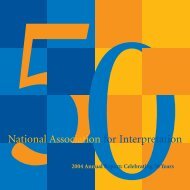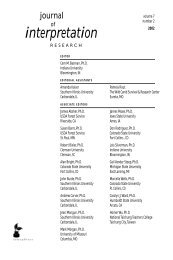interpretation
Volume 15, Number 1 - National Association for Interpretation
Volume 15, Number 1 - National Association for Interpretation
You also want an ePaper? Increase the reach of your titles
YUMPU automatically turns print PDFs into web optimized ePapers that Google loves.
i m p r o v i s a t i o n a l t h e a t e r g a m e s f o r c h i l d r e n in p a r k i n t e r p r e t a t i o n<br />
Conclusion<br />
These results suggest that incorporating improvisation games into interpretive programs<br />
can contribute to enjoyment and perceived learning of children. Sensory awareness,<br />
physical involvement, collaboration, creativity, and guided interaction helped increase<br />
enjoyment and perceived learning. These characteristics support the models proposed by<br />
learning theorists. In particular, Piaget argues that play is critical to a child’s cognitive,<br />
social, and emotional development (Singer & Revenson, 1996). The act of playing<br />
enables children to determine their role in their environment (Mearns, 1977) and helps<br />
to communicate complex ideas (Edgar, 2006). Furthermore, children up to the age of<br />
12 can learn about abstract concepts by interacting with tangible objects, using all of<br />
their senses (Vasta et al., 2004). Moreover, the activities resulted in appropriate insights<br />
and curiosity about Banff National Park. These new interpretive approaches are critical<br />
today when many children have fewer opportunities to connect to nature.<br />
Further study on the use of improvisation activities, and their ability to reconnect<br />
children to nature, will be helpful. First, research should evaluate knowledge retention<br />
from these activities over time. Second, research should explore the influence of<br />
spontaneous content inherent in these theater games, compared to the goal of thematic<br />
<strong>interpretation</strong> (Tarlton & Ward, 2006). Third, research should compare evaluation<br />
responses among children with different ages and levels of cognitive development<br />
(Kellert & Westervelt, 1984). Last, research should compare the effectiveness of different<br />
types of creative dramatics in enabling children to learn about themselves and their role<br />
in their environment (Mearns, 1977).<br />
In terms of limitations, we had with little control over the number of participants<br />
each day, so it was difficult to play every game regularly. Second, parents may have<br />
influenced responses from younger children. Third, the program variability and small<br />
sample size did not allow for statistical comparisons among activities.<br />
In the future, the age range of participants should be restricted to enhance the<br />
potential learning among ages within similar cognitive development stages. As well, preregistration<br />
would help improve program planning. In general, improvisation can contribute<br />
to the enjoyment and perceived learning for children in interpretive programs, but it is<br />
important to consider group dynamics and individual preferences, since these factors may<br />
influence a child’s enjoyment or learning potential of any activity (Caine et al., 2005).<br />
Acknowledgments<br />
C. Hanson, R. Bray, M. Wilde, and S. Tarrington helped deliver and administer the<br />
program. Banff National Park and Parks Canada’s Personal Interpretation Innovation<br />
Fund provided financial support.<br />
References<br />
Adamson, D. (2004). Learning through play the natural way: Nature based activities<br />
promoting environmental education for young children. Langley, BC: Adamson<br />
Educational Services.<br />
Beck, L., & Cable, T. T. (2002). Interpretation for the 21st century: Fifteen guiding<br />
principles for interpreting nature and culture (2nd ed.). Champaign, IL: Sagamore<br />
Publishing.<br />
v o l u m e 15, n u m b e r 1 11












